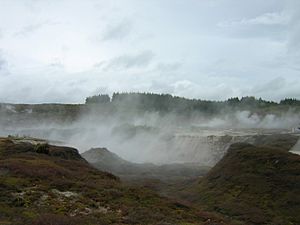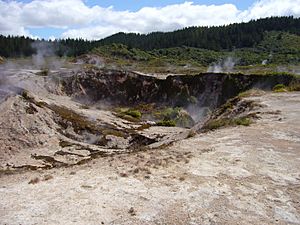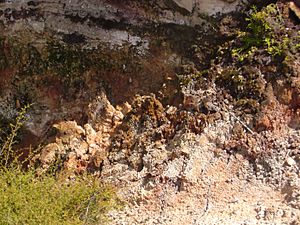Craters of the Moon (geothermal site) facts for kids
The Craters of the Moon Thermal Area is a special place in New Zealand where steam and hot gases come out of the ground. It's also known by its Māori name, Karapiti. This area is part of the huge Wairakei geothermal field, which is the biggest in New Zealand. It covers about 25 square kilometers and is located in the Taupo Volcanic Zone.
The name "Craters of the Moon" comes from the many holes in the ground, called eruption craters. These craters are often bare and show bright colors. Steam constantly rises from the ground, making the area look a bit like a different planet. The smell of sulfur adds to this "unearthly" feeling. These craters are quite new and appeared because of human activities in the area.
The land belongs to the government and is looked after by the Department of Conservation. A group of volunteers called the Craters of the Moon Trust also helps out. They give information to visitors and help keep cars safe in the parking area.
Contents
History of Craters of the Moon
In 1859, a scientist named Ferdinand von Hochstetter visited the area. He saw a huge column of steam rising from a spot called the Karapiti Blowhole. You could see this steam from about 20 kilometers away! It was hard to get close because the ground was warm and soft.
By the early 1900s, the Karapiti Blowhole became a popular spot for tourists. People even called it "the safety valve of the North Island." Imagine watching this at night! Guides would light a sack with kerosene and shake the burning pieces into the blowhole. The steam would carry the sparks up, creating a wild fireworks show. People believed this blowhole had been active for at least 200 years. Māori people used its steam as a guide for their canoes across Lake Taupo.
In 1950, the area was mostly warm clay with some hot spots and mudpools. The Karapiti Blowhole was still impressive, but not as strong as before.
How the Power Station Changed Things
A big change happened in the 1950s when the Wairakei Power Station was built nearby. This power station uses the heat from underground to make electricity. Building it changed the pressure of the hot water systems deep below the earth.
Because of the power station, the geothermal activity at Craters of the Moon changed a lot. Other hot spots, like the geysers at Wairakei Geyser Valley, completely disappeared. But at Craters of the Moon, the heat coming out of the ground actually increased! Many new craters formed from "hydrothermal eruptions." These are like small explosions where hot water and steam burst out.
In 1950, the total heat from Craters of the Moon was about 40 megawatts (MW). By 1964, it had jumped to 420 MW! After that, it slowly went down to about 200 MW by the year 2000. The Karapiti Blowhole also changed. Its heat output grew until the mid-1960s, then it dropped. The blowhole finally stopped working completely in 1987.
What Can You See at Craters of the Moon?
Craters of the Moon is a steamfield that covers about 36 hectares (about 0.36 square kilometers) of heated ground. It sits about 435 meters above sea level. As its name suggests, it has many craters. But you can also see "fumaroles" (which are like steam vents) and a bubbling mudpool. The plants growing here are quite unusual because of the warm ground.
What are the Craters?
All the craters at Craters of the Moon were formed by hydrothermal eruptions. This happens when steam pressure builds up under the ground. When the pressure gets too high, it causes an explosion! Hot water, steam, mud, and small rocks can be shot up to 100 meters into the air. This leaves behind holes or craters that can be as deep as 20 meters. These types of eruptions happen about once a year.
What are Fumaroles?
Fumaroles are openings in the earth where hot steam and gases escape. They can be very small, just a centimeter wide, or as large as half a meter across. The most powerful fumarole seen at Craters of the Moon happened in December 1967. It released a huge amount of heat, about 116 MW!
What is a Mudpool?
Right now, only one of the craters has a mudpool. Here, gases (like hydrogen sulfide) mix with water to create sulfuric acid. This acid then reacts with the rocks, turning them into clay. When there's enough water, this clay forms grey mudpools. They bubble and burp as steam and gas push their way through.
Plants at Craters of the Moon
Much of the ground at Craters of the Moon is warm or hot. This makes it hard for most plants to grow. Only a few special types of plants can survive here. One is the prostrate kanuka, which is a type of kanuka tree. You can also find ferns and mosses that usually only grow in warm, tropical places.
Visiting Craters of the Moon
Craters of the Moon is open to visitors all year round. It's easy to get to by car from Taupo. You just take Karapiti Road, which branches off State Highway 1/5, about 4 kilometers north of Taupo. There's a parking lot and a small building with information at the entrance. You do need to pay a fee to enter.
Visitors can walk on a main loop track that takes about 45 minutes. It's suitable for all ages and is even wheelchair accessible. There's also a steeper loop that takes an extra 20 minutes and leads to a great viewing point. Because of the steam and hot ground, the paths and wooden walkways are sometimes moved to keep visitors safe.
Craters of the Moon Trust
The Craters of the Moon Trust is a volunteer group. In 1991, there were many car break-ins at the parking lot. A local lawyer, Jeremy Nash, asked for volunteers to help keep the area safe. That same year, a small information kiosk was built. In 2000, a bigger kiosk was opened. The Trust also started a similar service at the famous Huka Falls in 2000.
Images for kids








